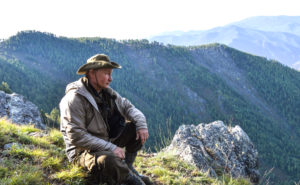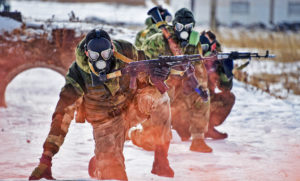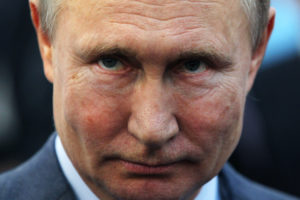As winter came to the city of Kyiv, its people waited for the cataclysm. For months the tension had been mounting. They had seen what became of other cities that defied the Mongols, but their governor had refused to surrender, hoping against hope for foreign intervention.
But now Batu Khan’s army had arrived in force, and the longed-for Hungarians were nowhere to be seen. On 28 November 1240, the besiegers set up their siege machines at the Polish Gate. The bombardment began immediately, day after day of shock and awe. On the eighth day the walls gave way, and the Mongols poured into the city, looting, raping and killing.
For hours the Kyivans fought to defend their capital, house by house, hand to hand. By the next morning hundreds of civilians had taken refuge in the Church of the Dormition of the Virgin, resting place of Kyivan princes since the days of Volodymyr the Great. So many people stampeded up the stairs towards the dome that the structure collapsed beneath their weight. There was no escape from the horror.
Nobody knows how many Kyivans died in the next few hours, though the total probably ran into the tens of thousands. Medieval chroniclers estimated that of 50,000 residents, only 2,000 survived. Formerly one of the largest cities in Europe, Kyiv was reduced to ashes. When a papal envoy visited the site six years later, he found it a post-apocalyptic wasteland. Of dozens of large buildings before the siege, just six still stood, and there were “countless skulls and bones of dead men lying about on the ground”. Kyiv, he reported, had “been reduced almost to nothing”.
Yet Kyiv endured, and Kyiv rose again.
That has been the story of Ukraine and its people since the beginning: a story of appalling suffering and indomitable courage, terrible cruelty and extraordinary resilience. Writing amid the news of Russian strikes on the Ukrainian capital, with apartment blocks in flames and civilians taking refuge in underground stations, it’s hard not to think of the resonances with the past. The gathering sense of doom, the desperate hopes for Western intervention, the unleashing of the terrible storm. Kyiv fell, and its people endured Mongol rule for more than a century. But their descendants never forgot who they were. They endured, and they rose again.
History is at the heart of today’s horrific slaughter. Vladimir Putin believes in history, apparently to the point of near-madness. He believes in his own importance as a great man, in his country’s unique nature and exceptional destiny. He is driven by a seething resentment at the ebbing of Russian power, his fury at its supposed encirclement by Nato conspiracies, his outrage at the collapse of the Soviet empire, which he believes “the greatest geopolitical catastrophe of the century”.
But Putin is also driven by his sense of Ukrainian history. To put it simply, he believes there is no such thing; or rather, that Ukrainian history is Russian history. Last summer, in an explicit warning the West utterly failed to heed, he published a 7,000-word essay entitled ‘On the Historical Unity of Russians and Ukrainians’. In the very first line he wrote that “Russians and Ukrainians were one people — a single whole”. He traced their shared origins back to the state of Kyivan Rus, founded by the Vikings in the ninth century. Again and again he insisted that Ukrainians were not really Ukrainians, but “western Russians”. Modern Ukraine, he concluded, was a fiction, “entirely the product of the Soviet era”, artificially established “on the lands of historical Russia”.
Does anybody doubt that Putin means what he says? Just listen to his chilling speech on Monday evening, his declaration of war on his beleaguered neighbour. The message was exactly the same. “Since time immemorial,” Putin said, “the people living in the south-west of what has historically been Russian land have called themselves Russians and Orthodox Christians.” Ukraine’s very existence, he insisted, was a mistake, an aberration by Lenin and the Bolsheviks in the early Twenties.
So why do the Ukrainians persist in believing otherwise? Again Putin’s answer was simple. They have been tricked by the West and misled by their masters, a gang of “nationalists and neo-Nazis”. His operation, he says, is designed to bring the “demilitarisation and de-Nazification of Ukraine”. Never mind that Ukraine’s president, the former actor Volodymyr Zelenskyy, looks nothing like a Nazi. Far from being a Ukrainian ultra-nationalist, he comes from a Russian-speaking family. His grandfather joined the Red Army to fight the Nazis. His great-grandfather was killed in the Holocaust. Volodymyr Zelenskyy is Jewish.
That tells you all you need to know about Vladimir Putin’s command of history. For he is wrong: comprehensively, utterly, inarguably wrong. It is true that Russians and Ukrainians have complicated family relations and shared historical roots. But they are not the same people, and Ukraine is not Russia.
Yes, both peoples are East Slavic, both are largely Orthodox and both look back to the ninth and tenth centuries, when the Vikings established the realm they called Garðaríki — the “kingdom of cities” — in what we now call Ukraine, Belarus and western Russia. But their paths diverged after the Mongol invasion, which is why the siege of 1240 matters so much. Imperial Russia grew out of the Grand Duchy of Moscow, one of Kyiv’s regional rivals, which flourished as a Mongol vassal.
But the lands of modern Ukraine did not belong to Moscow. To cut an incredibly contentious story short, they were eventually divided three ways. In the south, Crimea and its hinterland became an independent khanate, run by the Mongols’ Golden Horde and its successors. In the far east, the wide steppes known as the Wild Fields became the lands of the Cossacks — exiles, outlaws and adventurers, who take their name from the Turkish word kazak, “a free man”. But most of today’s Ukraine fell beneath the sway of the vast Polish-Lithuanian Commonwealth, one of the largest, most populous, most cosmopolitan and most tolerant countries in early modern Europe. And if you want to know why, in the last few days, Poland and Lithuania have been Ukraine’s staunchest champions, there’s your answer.
Every detail of this story is bitterly contested; to leave anything out invites fierce criticism. But here’s a foolhardy attempt at a summary. For centuries, most of Ukraine’s largely peasant people were governed by the Poles, and had much in common with their Russian neighbours. But they were not Poles, and they were not Russians. At the time people called them “Ruthenians” — a word derived from that original Viking state of Kyivan Rus. But the word Україна, Ukraine, is old, dating from at least the 12th century. It probably means “the edge, the borderland”. And that pretty much sums Ukraine up. It was the land in between.
It’s perfectly true that over time, Ukraine turned to look eastwards. By the early 19th century Poland had been destroyed, while most of modern Ukraine, including the lands of the Cossacks and the capital Kyiv, had been absorbed by the empire of the Tsars. Not the far west, though: it was taken by Austria-Hungary, which is why L’viv looks so much like Krakow or Prague. Meanwhile, in the east, in the coal basin of the river Don, Russian workers poured into the newly built mines and steelworks, which is why so many eastern Ukrainians still speak Russian.
But that’s not an unusual story. At exactly the same time, a very similar thing happened here in Britain, where English workers moved into the mines and steelworks of South Wales. Today their descendants still speak English; you don’t often hear Welsh on the streets of Cardiff. But an anglophone Welshman is still Welsh. Like his childhood friends in the steel-making city of Kryvyi Rih, Volodymyr Zelenskyy was brought up speaking Russian. But he’s not Russian. He’s Ukrainian.
So was Ukraine invented by the Bolsheviks, as Putin says? No. Just look at its cities and universities in the late 19th century, when the Ukrainian idea flourished as never before. Intellectuals, poets, historians and folklorists became fascinated by their unique past and distinctive culture, just like their counterparts elsewhere. All over Europe, from Ireland, Germany and Italy to the lands of the Czechs, the Bulgarians, the Serbs and the Poles, people were part-uncovering, part-inventing their own national stories. So too in Ukraine, where the national poet Taras Shevchenko, the son of a serf, wrote verses celebrating the peasants, rebels and outlaws of days gone by.
But of course that didn’t fit with the Russian story. Under Tsars Nicholas I and Alexander II, the Ukrainian ideal seemed a threat to the unity of the Russian Empire. Shevchenko was arrested and exiled, his poems suppressed. In 1876 the Ukrainian language was effectively banned. You couldn’t write Ukrainian books, put on Ukrainian plays or give Ukrainian recitals; you couldn’t even teach your children in Ukrainian.
Yet Ukraine endured. By the outbreak of the First World War, the national idea was probably stronger than ever. At first the Russians invaded the Austrian-held west, in Galicia, and tried to stamp out all traces of a distinct Ukrainian identity. Then they were driven back. The Russian Revolution and civil war brought chaos, and Kyiv changed hands 16 times in two years. But every rival contender — the Ukrainian People’s Republic, the West Ukrainian People’s Republic, the Hetmanate, the Directorate, even the Ukrainian Soviet Socialist Republic — believed there was such a thing as Ukraine. That was why, when Lenin and Stalin created the Soviet Union in 1922, Ukraine joined as a separate republic. Everybody knew it wasn’t Russia.
In the century that followed, Ukraine’s history was so awful, so horribly stained with sorrow, that it feels almost indecent to write it down. A famine in the early Twenties, then another horrific famine — the Holodomor, caused by Stalin’s collectivisation policies — in the early Thirties. Occupation by the Nazis in the Second World War, then the charnel house of the Holocaust, in which some Ukrainian nationalists actively took part. Reconquest by the Red Army; years of suppression and stagnation; the nuclear accident at Chernobyl. Then the collapse of the Soviet Union, the implosion of Ukraine’s economy in the decade that followed, the Orange Revolution, the Maidan and the annexation of Crimea.
Yet amid all this, Ukraine endured. In his speech on Monday night, Putin failed to mention that in the late Eighties thousands of people took to the streets of L’viv and Kyiv to demand language rights, greater autonomy and, in the end, independence. Nor did he mention that when the Ukrainians were given the chance to go their own way, in a free and fair referendum in December 1991, a staggering 92% voted for independence. Every single oblast, even Donetsk, even Luhansk, even Crimea, said yes. Even Russian-speakers voted for it. And no wonder. They were, after all, Ukrainian.
A complicated story, then. But in a European context, it’s not so unusual. Yes, Ukraine’s borders have been fluid; but whose haven’t? Just look at a map of Germany over time; or Italy, or Poland. Yes, many Ukrainians speak Russian. But that’s not unusual either. Some Finns speak Swedish. Some Germans speak Danish. Some Italians speak German. Do the Swiss all speak the same language?
And yes, Ukraine’s history is deeply, inevitably intertwined with that of its overbearing neighbour. It always has been, and always will be. But you could say exactly the same of Spain and Portugal, Germany and Austria, Britain and Ireland. Most people in Ireland speak English. Many read English newspapers. Many even support English football teams. But Ireland isn’t England. Ukraine isn’t Russia.
For Ukraine, doomed to what appears to be unending suffering, the future seems grim. When I began this essay, opening with those lines on the fall of Kyiv in 1240, the BBC headlines talked of overnight air attacks on the city. Now, while I have been writing, Russian tanks are rolling into the suburbs. Historians love to quote Mark Twain’s quip that history doesn’t repeat itself, it rhymes. They rarely admit that sometimes it rhymes in dreadful, unbearable, heart-rending ways.
But the story of Ukrainian history isn’t just a story of endless defeat. It’s a story of endless resilience. It’s the story of a people trapped between mighty neighbours, who have always been themselves, with their own land, their own identity, their own history. You can bomb them and kill them, smash their cities and tear down their buildings, burn their books and suppress their language. But you can’t make them something they aren’t, and you can’t destroy their belief in themselves. That’s the story of the siege in 1240, and it’s the same story now. Kyiv fell. But Kyiv endured, and Kyiv will rise again.
*
Dominic Sandbrook and Tom Holland discuss the history of Ukraine in the latest episode of The Rest is History.
Disclaimer
Some of the posts we share are controversial and we do not necessarily agree with them in the whole extend. Sometimes we agree with the content or part of it but we do not agree with the narration or language. Nevertheless we find them somehow interesting, valuable and/or informative or we share them, because we strongly believe in freedom of speech, free press and journalism. We strongly encourage you to have a critical approach to all the content, do your own research and analysis to build your own opinion.
We would be glad to have your feedback.
Source: UnHerd Read the original article here: https://unherd.com




